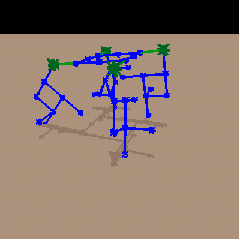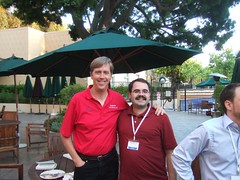Yay! Raeford Parachute Center finally sent my skydiving video!
You can read about the experience here.
Yay! Raeford Parachute Center finally sent my skydiving video!
You can read about the experience here.
“One of the strongest motives that lead persons to art or science is a flight from the everyday life. With this negative motive goes a positive one. Man seeks to form for himself, in whatever manner is suitable for him, a simplified and lucid image of the world, and so to overcome the world of experience by striving to replace it to some extent by this image. This is what the painter does, and the poet, the speculative philosopher, the natural scientist, each in his own way. Into this image and its formation, he places the center of gravity of his emotional life, in order to attain the peace and serenity that he cannot find within the narrow confines of swirling personal experience.”
– Albert Einstein
“I’m struck again by the irony that spaceflight – conceived in the cauldron of nationalistic rivalries and hatreds – brings with it a stunning transnational vision. You spend even a little time contemplating the Earth from orbit and the most deeply ingrained nationalisms begin to erode. They seem the squabbles of mites on a plum.”
The multi-talented programmer, vintage arcade enthusiast, artist, and iPhone game developer Peter Hirschberg created a one-of-a-kind private vintage arcade collection that he periodically opens to the public. His Luna City Arcade is an acclaimed collection of still-functioning vintage arcade games from the 1970s and 1980s that he keeps and maintains in a 2400 square foot building next to his house.

Luna City Arcade. Image by Peter Hirschberg.
This past Saturday, Iris and I hopped in the car and drove up to Luna City Arcade. We met up with the McCubbins and enjoyed a day of beeping and chippy nostalgia.
Peter and his wife were gracious hosts and we had a great time. Check out Peter’s newest iPhone game, Vector Tanks, a throwback to the days of Battlezone, and Adventure Revisited, his clone of the classic Atari game Adventure for Windows and Mac. And take a look at his software portfolio for an interesting collection of simulators, emulators, and novelties that he’s created.
Obama held a rally here in little ol’ Roanoke on Friday. He is the first major-party presidential candidate since JFK in 1960 to visit Roanoke. So, Kathryn and I took the day off and waited in the cold, wet line with our friend Kelly to witness this historic event. Here is a video showing highlights of our day:
WARNING: The video shows an anti-abortion truck that was parked near the line. Plastered on all sides of the truck is a gruesome image of an aborted fetus, accompanied by the message “Abortion is an ObamaNation”. We’ve seen similar images and statements proudly held by protesters hanging out near the Planned Parenthood facility in town. I was hoping to see more protesters at the rally, but the best we got was two zealots holding signs with biblical quotes, and some McCain/Palin supporters dressed as Joe the Plumber, who we didn’t see but found out about later via CNN:
Despite the cold rain, everybody was in good spirits. When we got inside and Obama finally reached the stage, the crowd went wild. He spoke with his usual eloquence, hitting many of his usual stump speech points. Including his crowd-pleasing pie story. I think the only big new point he made was his accusation that McCain wants to cut Medicare, an accusation based on a Wall Street Journal article.
It was very interesting to experience the Obama visit in person. Kelly thought the crowds swarming around Obama looked like a school of fish, all changing direction simultaneously during a feeding frenzy. We all marveled at the amount of logistical planning, endurance, expense, and show business required by presidential campaigns. And it’s all going to end two weeks from Tuesday. GO VOTE!
(We also took a few photos during Friday’s rally.)
Article sections: Atlanta | GECCO 2008 | Contests | Research
The Atlanta trip was a lot of fun. We stayed in a really nice rental house not far from Turner Field. The McCubbins managed to put up with me for a week and even went so far as to make dinner for me on several occasions. You haven’t had a good meal until you’ve tried their cooking. Mmm, tuna bites, fruit and goat cheese salad, steak, and black bottomed cupcakes. Our friends Jon and Kate are also accomplished cooks – we should host a cookoff between both couples so we can reap the delicious benefits.

Between home-cooked meals we sampled a variety of Atlanta dining options. Chris and I ate at Gladys and Rons Chicken and Waffles, a restaurant chain started by Gladys Knight that serves the most delicious fried chicken and waffles I’ve ever had. The waffles are warm and soft on the inside and nice and crispy on the outside. Perfect. And eating there has only amplified my weakness for fried chicken. I also managed to meet up with the Atlanta-based contingent of my LegalEdge coworkers at the Vortex Bar and Grill. While I did not sample the infamous bypass burgers, I did partake of the big-ass mushroom swiss burger, and my brain’s burger receptors were alight with glee. This celebration of manliness was a mere coverup for the earlier, emasculating experience of eating at the American Girl Boutique and Bistro to celebrate Eris’ fifth birthday. Despite the pink/pastel surroundings, bad service, and proliferation of little girls tending to their creepy shark-eyed dolls, we had a great time and the food was really good.
We checked out the Georgia Aquarium and World of Coca Cola during our stay. The aquarium is fantastic; definitely a must-see. The whale shark tank there is a massive, imposing, wondrous display. The Coca Cola museum is fun but they really hammer you with Coca Cola propaganda while you are there. YOU MUST DRINK IT. The tasting room is awesome, though. In it you can try unlimited samples of around 70 different Coca-Cola products sold around the world. We shuffled among dispensers over the sticky floors and tasted all sorts of delicious sugary carbonated water, and occasionally experienced horrid drinks such as Beverly. The tasting room gets you nice and high on sugar and caffeine before you go to the gift shop, which is the only way to exit the museum. A brilliant scheme to coax dollars from your wallet.
My trip photos | Chris and Angel’s trip photos
According to Nic McPhee’s twitters, GECCO 2008 had 471 attendees from 46 countries. This universal appeal of scientific research is one of things I liked about last year’s GECCO conference, too. This year’s conference, though, was almost as bad as last year’s when it came to feeding the attendees. Food was given out during the two hour poster session where I was presenting my poster, but all the food was gone in less than 20 minutes, and it was not replenished. Boo!
Nevertheless, there were plenty of fascinating presentations and workshops. The keynotes were again from experts in the field of biology, source of many of the great ideas in evolutionary computing. Dr. Martin I. Meltzer, senior health economist at the Centers for Disease Control, gave an interesting keynote talk about developing scientific models to study public health policy and how well we’d react to sudden outbreaks of disease. In particular, he used the example of pandemic influenza. Overall it was a fascinating but extremely depressing talk, since much of it dwelled on how unprepared we are for situations such as the 1918 flu pandemic. Well-known biology professor, popular science blogger, fierce skeptic, and “expelled from Expelled” victim PZ Meyers gave the second keynote talk. He spoke about the importance of development during evolutionary processes (aka “evo-devo”). For example, many animals share the same exact genes but the organisms themselves have vast differences. The differences are due to other important developmental processes outside of the animals’ genes. He talked about some interesting specific examples, such as development of bats and mice. Cretekos et al (2008) recently chopped out a regulatory sequence from bats and stuck them into mice. The mice then developed longer forelimbs, corresponding to the lengthened forelimbs of bats needed for flight. PZ’s blog post explains this in more detail (and with cool pictures!) This example showed that there are many elements at play that create variety in organisms, and many of these elements are strongly influenced by their environment. We are only barely beginning to understand how these things all work together to form life.
PZ’s other interesting example of environmental factors in evolutionary development was Suzuki and Nijhout’s 2006 paper “Evolution of a Polyphenism by Genetic Accommodation”. The researchers were able to evolve environmentally-driven traits in a type of caterpillar. In cooler temperatures, the evolved caterpillars remain black in color. But some of the ones exposed to hotter temperatures turn green in color; all the rest remain black. So the experimenters selected the greenest caterpillars and let them breed with each other. They also selected the black, unchanging caterpillars and bred them with each other. Over a small number of generations, descendants of the green-changing caterpillars more reliably changed colors, while the unchanging caterpillars reliably resisted changing colors in hotter temperatures. Read PZ’s post for more interesting info on how this all works. It reminds me of Ryan Somma’s post about Daisyworld, a thought experiment world in which black and white daisies affect the temperature of their planet as well as their own survival.

Here are some other links recounting PZ’s Atlanta visit: PZ blogging about a meet up with his blog readers. Detailed description of the keynote. PZ’s post about his GECCO keynote (including a PDF of his slides).
Chris and I entered the 2D packing problem contest, where you have to evolve a grid of numbers that yield the highest scores for adjacent pairs of numbers. We didn’t win but we did well enough to give a presentation about our approach. We developed an “embryonic” growth technique to evolve the 2D grid, using block-based growth, and something that ended up looking like mold.
Other contests included evolving Rubik’s cube solvers on a massively parallel grid computing platform (the winner gets $1000), evolving L-systems to match pre-existing images, and evolving intelligent agents to search a virtual landscape for food as efficiently as possible. Nobody qualified for the Rubik’s cube contest, and nobody entered the L-system contest. Which is too bad, since they are very interesting problems. And the $1000 bounty for the Rubik’s cube problem remains unclaimed; Parabon is keeping the competition open and is upping the ante to $2000 for GECCO 2009.
There was also the so-called “HUMIES” awards, which is a competition to showcase evolutionary methods that match or outperform human efforts to solve problems. The winning paper used genetic programming to evolve ways to find special algebraic terms that no human has been able to accomplish.
Below is a list of some of the other presentations and papers that interested me:




There were many more interesting papers, too numerous to describe, showcasing the widespread and diverse applications of evolutionary computing. Some examples include evolving circuits with high testability, automatic defect classification in electronic wafer manufacturing, quantifying quality degradation on voice-over-IP networks, detection of malware (including zero-day virus attacks) using techniques inspired by biological immune systems, evolving color schemes for people with color blindness, investment portfolio optimization, modeling the Milky Way galaxy using BOINC volunteer computing, developing no-loss strategies for tic-tac-toe, finding deadlocks in large concurrent java programs, radar jamming, evolving functions that can detect computer program code plagiarism by students (beware, cheaters!), automatic route planning that takes traffic into consideration, automatic composition of rock music using genetic algorithms (seriously?), interactive evolution of facial composites of suspects in criminal investigations, detection of moving objects in videos, using a bacterial foraging algorithm to detect circles on images (wait, what?), evolving a World Computer Chess Champion-beating chess program by mimicking the behavior of a mentor, and prediction of whether a company will have financial losses.
The list goes on. But I’ve punished you long enough with this mercilessly long post. Long story short: Trip good. Science good. Computers fun.
Last month, we heard about a KIVA outing here in Roanoke to get families and their kids to come out for a short hike and bug hunt. Turns out the Today Show was filming a story about “nature deficit disorder”, the idea that kids just aren’t getting out and connecting with nature as much as they used to. Iris brought a little glass jar to collect bugs and other creatures she found on the hike, and she scored a small interview with the Today Show folks:
We were pretty excited to see her on national TV!
Here is the entire news story:
She has a small appearance at about 1:23 into the second video (she’s on the right, bending down to look and then moving away). Her little interview starts at 2:14. I’m very proud of her!
My friend Chris recently got to meet Jeff Hawkins (neuroscientist, founder of Palm Computing and Handspring, inventor of the Palm Pilot and the Treo, author of On Intelligence, founder of Numenta, developer of the idea of “Hierarchical Temporary Memory”):

Pretty nifty! Chris gets to play with Numenta’s HTM software at his job at APL (lucky bastard). But everyone else can play, too, because the software is available to everyone here: Numenta Platform for Intelligent Computing (NuPIC). Get your A.I. on!